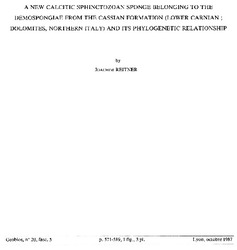A new calcitic Sphinctozoan sponge belonging to the demospongiae from the Cassian formation (Lower Carnian; Dolomites, northern Italy) and its phylogenetic relationship
Zeitschrift: Geobios, 198720, 5: 571 - 589
Reitner, Joachim, 1987: A new calcitic Sphinctozoan sponge belonging to the demospongiae from the Cassian formation (Lower Carnian; Dolomites, northern Italy) and its phylogenetic relationship. In: Reitner, Joachim (1987): A new calcitic Sphinctozoan sponge belonging to the demospongiae from the Cassian formation (Lower Carnian; Dolomites, northern Italy) and its phylogenetic relationship - Geobios; Vol. 20, Nr. 5, p. 571-589, DOI: 10.23689/fidgeo-2509.
 |
Dokument öffnen: |
A new species of a coralline sponge, Cassianothalamia
zardinii n. gen. n.sp., from the Lower Carnian
Cassian Beds (northern Italy) is described. The new
species possesses a secondary thalamid basal skeleton
with a spongocoel and the internal structure is constructed
of horizontal elements (trabecula) and vesiculae.
The microstructure of the basal skeleton is composed
of an irregular high Mg-calcite. From the spicular
skeleton aster-microscleres can be preserved. In
rare cases, monaxonid megascleres can also be found.
Therefore the new sponge is probably a representative
of the demospongid order Hadromerida. Une nouvelle espece d'eponge coralline, Cassianothalamia
zardiini n.gen. n.sp., a ete trouvee dans les
couches du Carnien inferieur de Saint-Cassian. La
nouvelle espece possede un squelette basal thalami de
secondaire muni d'une cavite pseudogastrique et sa
structure interne est constituee d'eIements horizontaux
(trabecules) et de vesicules. La microstructure de
la partie basale du squelette est composee d'une calcite
irreguliere a forte teneur en Mg. Les microscleres
asteroYdes du squelette spiculaire peuvent avoir ete
conserves. On peut aussi trouver tres rarement des
megascleres monaxonides. Par consequent, cette nouvelle
eponge est probablement un representant de
l'ordre Hadromerida des Demosponges.
Statistik:
ZugriffsstatistikSammlung:
- Geologie [931]

